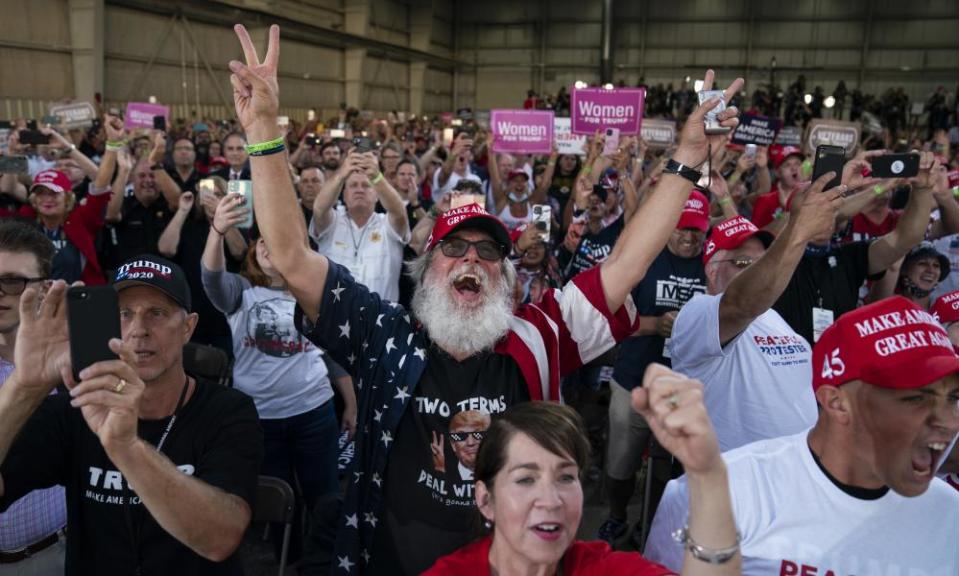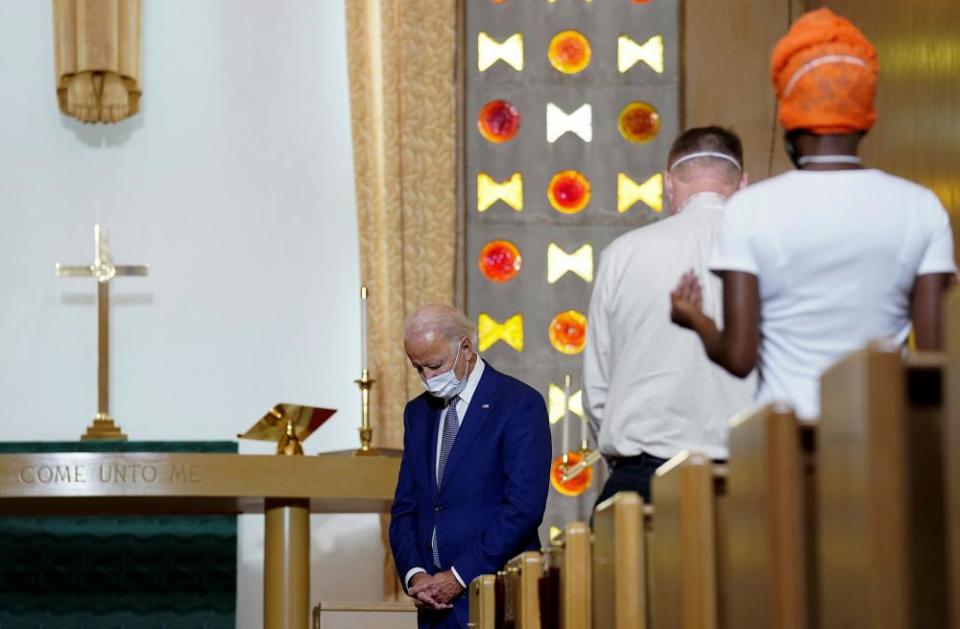'Cacophony of chaos': why the US election outcome is more uncertain than ever

It was just like old times. Donald Trump stood at a presidential lectern, encouraging a rambunctious crowd of supporters – few of whom wore face masks or physically distanced – to turn and boo the “fake news” media. Behind him Air Force One bathed in a glorious sunset, a huge US flag dangled from a crane and two giant signs declared, “Make America great again!”
Thursday’s outdoor campaign rally at an airport hangar in Latrobe, Pennsylvania, carried echoes of 2016 when Trump whipped up excitement in unglamorous corners of battleground states to overthrow conventional wisdom and edge out Hillary Clinton. Once again, Trump is drawing bigger and noisier crowds than his rival Joe Biden.
But in 2020 the political crystal ball is cloudier than ever.
It was President George W Bush’s defense secretary, Donald Rumsfeld, who once ruminated on “known knowns”, “known unknowns” and “unknown unknowns – the ones we don’t know we don’t know”. The 2020 presidential election is now a smorgasbord of all three.
Related: 'The politics of racial division': Trump borrows Nixon's 'southern strategy'
Can the opinion polls be trusted, or are they missing “hidden” Trump voters? Could Biden, like Clinton, win the popular vote but lose the electoral college? Will people vote by mail, despite the president’s efforts to undermine the postal service, or feel safe queuing to vote on election day in the middle of a global pandemic? Will the result be known on election night or take days or even weeks? Could the result – like 2000 – by decided in the courts?
“You couldn’t script this any worse, short of hurricanes and earthquakes taking place at the same time across the country,” said Tara Setmayer, a political analyst and former Republican communications director on Capitol Hill. “It is a cacophony of chaos being mixed together all at once as we approach election day.”
One of the strategies Trump employs is chaos...that’s the way he’s governed and that’s the way he’s campaigning
Tara Setmayer
The miasma of uncertainty was apparent over the past week when a batch of polls and burst of campaigning gave conflicting signals. Some observers were adamant they showed Biden holding on to a solid lead of seven or eight percentage points, higher than Clinton’s at the same stage, and praised him for displaying both empathy and steeliness in a series of speeches. “5 reasons Biden’s odds of victory look better than ever,” ran a headline in New York magazine on Thursday.
Others, however, detected a shift in momentum and polls tightening, especially in swing states. “Of course Trump can win,” ran a headline in the Washington Post. Film-maker Michael Moore wrote: “I’m warning you almost 10 weeks in advance. The enthusiasm level for the 60 million in Trump’s base is OFF THE CHARTS! For Joe, not so much.” There was panic that Biden has been thrown on to the back foot by Trump’s demand for “law and order”.

The sense of lost bearings is compounded by less traditional metrics, ranging from social media activity – Russian meddling and all – to anecdotal counts of campaign signs in voters’ front gardens to some pandemic-induced tactical wild cards. The Politico website reported last month: “Trump’s campaign knocks on a million doors a week. Biden’s knocks on zero.”
Overshadowing it all are the cascading crises of public health, economic recession, racial injustice and a president waging asymmetric warfare in his willingness to say or do anything to retain power.
Monika McDermott, a political science professor at Fordham University in New York, said: “It’s just a perfect storm of dysfunction. That’s what we’re looking toward right now. It’s a road we’ve never travelled before.”
Trump’s stunning upset win in 2016 led to a widespread belief that the polling industry is fundamentally broken. In fact the national polls were generally accurate in predicting that Clinton would win the popular vote by nearly 3m ballots. But they failed to spot how Trump would thread the needle of winning Michigan, Pennsylvania and Wisconsin by a combined total of fewer than 80,000 votes.
Axios recently warned that the public should have “even less confidence” this time around, arguing that the flaws in state polling persist because there are not enough big sample surveys that take into account typical Trump voter demographics, such as people who did not attend university.
Axios also noted that the pandemic is expected to lead to a record number of mail-in ballots but the postal service lack experience and states could struggle to process them. People’s ability to vote in-person on 3 November is another known unknown, for example due to shortages of poll workers.
McDermott added: “The reports of the death of polling were much exaggerated and too soon: the national polls nailed Hillary Clinton’s vote. It was much more accurate on a national level than it had been in either of the previous two presidential elections. For that, the polling industry deserves huge kudos because it was a relatively unknown situation with Donald Trump’s candidacy.
It’s just a perfect storm of dysfunction. That’s what we’re looking toward right now
Monika McDermott
“But I think the problem was that we don’t have enough polling in the states to know what’s going to happen with the electoral college so we can’t run the kind of reliable averages or things like that that we do for the national vote.”
Horse race narratives in the media are also shaped by perception.
Peaceful protests in Kenosha, Wisconsin, and elsewhere tend to pass unremarked but scenes of burning buildings and looting draw cameras and received wall-to-wall exposure on the conservative Fox News network. Trump seized on the images with a racially divisive message to accuse Democratic state governors and mayors of appeasing “domestic terrorists” and warn that a Biden victory would bring similar carnage to every city and suburb.
The former vice-president was forced to respond, and travelled to Kenosha two days after Trump, fueling commentary that he was on the defensive and losing control of a narrative that he wanted to focus on Trump’s mishandling of the virus. Alarm bells have also been rung by everything from Fox News’s high ratings to the popularity of conservative pundits on social media.

Kevin Roose of the New York Times wrote: “Listen, liberals. If you don’t think Donald Trump can get re-elected in November, you need to spend more time on Facebook.”
Roose detailed how his analysis of partisan content on the platform found that conservative politicians, pundits and topics dominate. “Pro-Trump political influencers have spent years building a well-oiled media machine that swarms around every major news story, creating a torrent of viral commentary that reliably drowns out both the mainstream media and the liberal opposition,” he added.
To illustrate the point, a visit by Nancy Pelosi, the Democratic House speaker, to a hair salon in San Francisco, where she was seen indoors without a face mask in violation of the city’s health guidelines, got little mainstream media coverage but was the number one story on Facebook. It was also amplified by Fox News, adding to worries that, in this polarised society of self-affirming bubbles, no one can see the full picture.
Some longtime observers believe that Trump’s strength may be underestimated, an effect magnified by the arbitrary distortions of the electoral college. Larry Sabato, the founder and director of the University of Virginia’s Center for Politics, said: “Everybody laughs about this because I’m a stats guy and you’re not supposed to do anything that’s not based on the data, but my scientific method leads me to add a point or two to Trump because there is actually a small hidden Trump vote.
“There is. We all know it. We’ve seen it in our offices and in our families. They’re always the silent ones. They don’t tell you they’re for Biden or for Clinton. They just don’t say. They’re ‘undecided’ or ‘I just hate the way it’s so negative’. Those kind of comments are a dead giveaway.”
Sabato added: “So it’s a point or two and then you have to add another couple of points for the electoral college. Trump lost the popular vote by two points in 2016, but he could lose it by three or four and probably win this time around. No Democrat will ever be able to do it but for a Republican it’s easy.”

“So you’re adding three, three and a half points to where he is in the polls. It’s close. Biden’s still ahead. Biden should win but it’s close enough so that this would not take some kind of massive dramatic turnaround for Trump to win, assuming things go well for him.”
To top it all, Biden is the oldest major party nominee in history, running mate Kamala Harris is the first woman of colour on a major party ticket and Trump himself is perhaps the least predictable candidate in history.
Setmayer, the host of the Honestly Speaking podcast, said: “Conventional wisdom has been thrown out the window since Donald Trump came down the escalator [to launch his campaign at Trump Tower] in 2015 and his tenure as president has only reinforced the fact that we don’t know anything about how things will play out.”
She added: “One of the strategies that Trump employs is chaos, and he thrives in that environment, that’s the way he’s governed and that’s the way he’s campaigning.”
Democrats are often accused of “quadrennial bedwetting” ahead of elections which is, at least, a safeguard against complacency. The known unknowns include three presidential debates that could change the trajectory of the race. Trump may yet spring an “October surprise” by announcing a Covid-19 vaccine. And in 2020 of all years, there are bound to be unknown unknowns.
John Zogby, a pollster and author, acknowledged that “Trump is on the ropes” but added: “It’s competitive. It looks especially competitive in the battleground states. So I would say at this point, 60-40 Biden. Which means I would bet you $50 – but I wouldn’t bet you $500.”

 Yahoo Finance
Yahoo Finance 